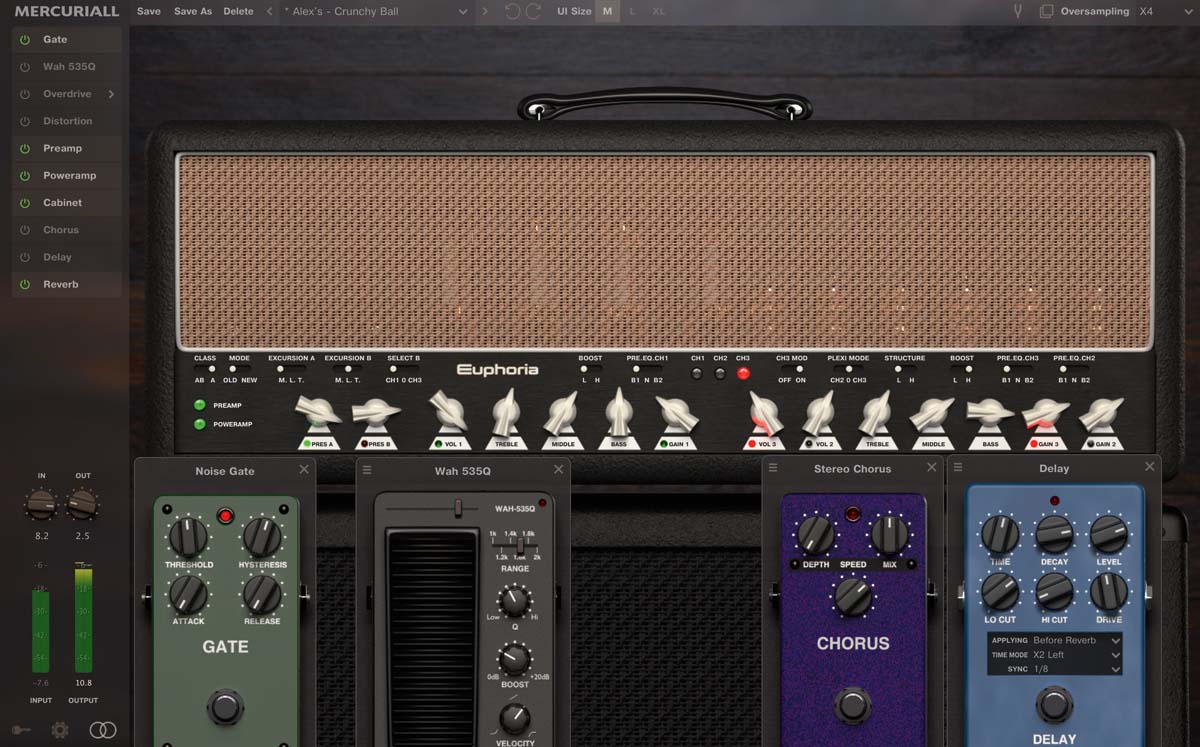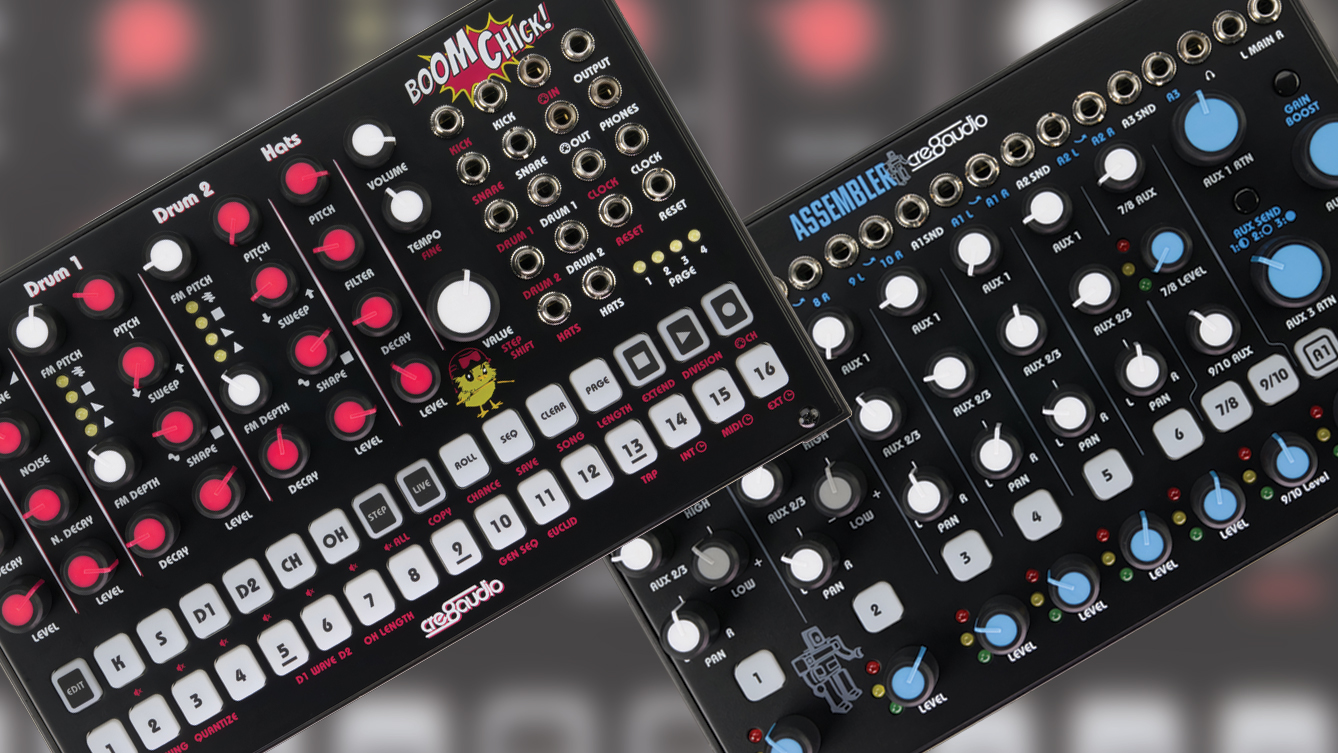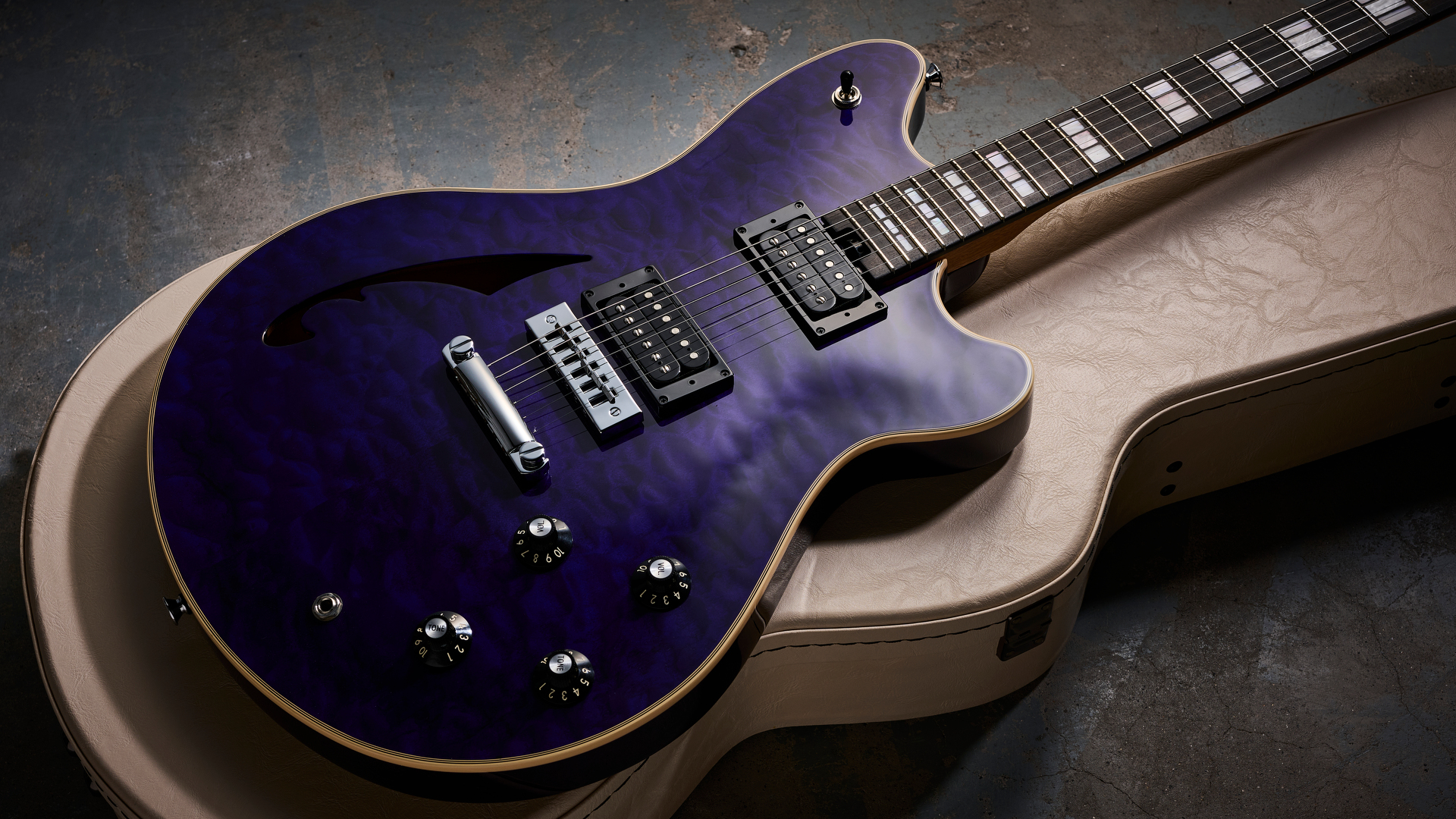MusicRadar Verdict
Not as flexible as some, but this still sounds awesome and is very competitively priced
Pros
- +
Cracking Bogner amp simulation with all the original settings.
- +
Crisp new window design.
- +
Good choice of key pedals.
- +
Flexible cabinet stage.
Cons
- -
Signal flow implementation could be better spec’d.
- -
Pedal order can’t as yet be set by user.
- -
High oversampling settings are very CPU intensive.
MusicRadar's got your back
What is it?
Software developers Mercuriall clearly have a thing about distortion, particularly the kind that’s derived from the world’s most respected guitar amps and pedals.
In fact it’s fair to say their guitar amp obsession most likely got them into audio software developing in the first place, and if you fancy trying out some of their early efforts they are free to download from their website.
Euphoria (VST, AU, AAX and standalone) is their latest ‘pay for’ release and is based on the Bogner Ecstasy 101B amp.
Much like Reaxis, their Mesa Boogie emulation, the amp emulation is part of a full rig, including pedals, amp, cabinet and post-cabinet effects. However, the big news is Euphoria introduces a brand new interface. Not only does this deliver a step up in realism, but it’s also more flexible, with floating windows handling the pedal, cabinet and post effects modules.
The new interface also adds some further new features including an input Tuner and Undo/Redo, and it can also be rescaled (M, L and XL). We understand that the plan is to roll out this new interface across their existing amplifier plugins, which is excellent news.
What really marks the Bogner Ecstasy 101B out as a boutique amp are the plethora of available settings that grace both the preamp and power amp sections, and they are all here
The Bogner Ecstasy 101B is a classic and very expensive boutique amp head first introduced in 1995. The 3-channel design delivers a massive range of tones from clean (CH1) to crunch (CH2) to classic high gain (CH3).
There are also some modded versions around as well and here Mercuriall have included the Mark Cameron CH3 mod. However, what really marks this out as a boutique amp are the plethora of available settings that grace both the preamp and power amp sections, and they are all here on Mercuriall’s emulation.
Starting with the preamp, you’ll notice that, in addition to Volume, Gain and 3-band EQ, CH1 has two pre EQ brightness settings (B1 and B2). There’s also a Boost option which turns this primarily clean channel into a more ballsy one. Next up, CH2 and CH3.
These share tone controls but settings are retained with each channel, which is a nice touch. Much like CH1, you have the pre EQ and Boost options as well as a gain setting (Structure) that influences the overall channel gain (high or low). Once again where these switches are shared, positions are saved with the channel.
All settings have a noticeable impact on the sound, and sometimes throw up surprises. Boost B2, for example, is cleaner than B1 for CH2 and CH3. The Plexi mode is also interesting as it’s less driven but more edgy than the regular CH2 and CH3 sounds.
All told, the preamp and power sections deliver an amazing array of core amp tones
Possibly the most subtle change is the CH3 mod, which adds some drive and articulation to the regular CH3 sound. Of course, the power amp section plays a role as well. Features include amplifier type (Class A or A/B), speaker cone damping (Excursion), Presence and a triode/pentode switch (Old/ New).
Class A delivers a retro sound, which is fuzzier and has more compression (guitarists call it sag), while A/B sounds more punchy. Excursion has three settings (T, L and M) and L (loose) delivers noticeably more bass, with T (tight) more scooped and M (medium) more balanced.
Finally, the Excursion and Presence have a pair of assignments (A and B) so you can have two different settings across the three amp channels. Very smart. All told, the preamp and power sections deliver an amazing array of core amp tones.
Neural Hybrid Engine
The successful fruition of analogue gear emulation has been one of the key wins for audio software development, and in the process, it has democratised the availability of expensive or rare hardware.
Arguably the best way of doing this is component modelling, whereby various parts of the hardware circuit are individually modelled and recreated using algorithms.
As they began software developing, Mercuriall followed this well-trodden path but along the way added an extra layer to the process, using artificial neural networks to learn particular input/output behaviours.
These could then be translated into algorithms and thus make the CPU intensive component modelling more realistic to implement. They continued to develop their Neural Hybrid Engine, and the latest v1.5 iteration can be found in Euphoria.
It includes further optimisations over the v1.0 system used in their SS-11X pedal plugin, though you can’t A/B the two engines in the same emulation so you can’t judge the difference.
At higher oversampling settings (x8 is the highest) Euphoria still has a considerable CPU hit. That said, it’s good to see developers striving to improve the sound and efficiency of their plugins.

Performance and verdict
Euphoria’s amp section is topped and tailed by processing modules in a fixed order. Four pedal slots are before the preamp: Gate, Wah, Overdrive and Distortion.
Meanwhile after the poweramp you’ll find the Cabinet, and then Chorus, Delay and Reverb. So, including the amp, that’s 10 modules in total, and the list down the side of the window with on/off for each also serves as a launcher for the pedals.

• Mercuriall Spark
Spark steers clear of complex rigs to deliver top notch Marshall amp tones with some excellent supporting pedals and effects.
• Positive Grid BIAS Amp 2
Immensely flexible modular-style plugin with amp-match capabilities.
• Brainworks ENGL E646 VS/E765
Choose one of these excellent boutique amp head emulations.
Many of the pedals are emulations of classics from Ibanez, Boss, Mesa/Boogie and Dunlop, and we particularly like the Super Overdrive and Metal Zone-inspired effects.
Moving on to the Cabinet, this is much like the one in Reaxis and is functional rather than fancy. You can blend two mics, each with distance and horizontal cone position, and there are four cabinets and three mics to choose from with modern scooped sounds (T-75) and more classic mid-range tones too (G12M).
The only slightly frustrating thing is you can’t pan the microphones. Alternatively you can provide your own cabinet impulse responses (EXT) and in both cases supplement sounds with your own reverb impulse responses (IR).
The new interface looks great and we like the floating pedal scheme, although it would be great to be able to re-order the effects
Euphoria sounds awesome and the amp emulation is one of the most flexible we’ve tried. The new interface looks great and we like the floating pedal scheme, although it would be great to be able to re-order the effects (we understand this is something that is under consideration).
We’d also like to see more control of the overall signal flow, preferably with panning for the cabinet mics. But these are minor gripes and shouldn’t detract from Mercuriall’s most impressive plugin to date.
MusicRadar Verdict: Not as flexible as some, but this still sounds awesome and is very competitively priced.
The Web Says
"The ground covered by Euphoria is staggering. If this was a blindfold test, I would think I was testing 3-4 different amps with multiple channels. There’s simply nothing it can’t do tone wise."
Honest Amp Sim Reviews
Hands-on Demos
Pete Thorn
Leon Todd
Sonic Drive Studio
Sergey Kasinec
Specifications
- TYPE: Guitar amp sim plugin (VST, AU, AAX, standalone)
- KEY FEATURES: Bogner Ecstasy 101B amp simulator w/ Cameron mod switch, 12AX7GTR preamp tubes, 12AX7GTR and EL34B poweramp tubes; reverb blend; tuner,
- CAB SIMS: Redwirez IRs, Bogner Uberkab 412 – 4x12 Celestion G12T-75, Mesa/Boogie 412 – 4x12 Celestion V30s, Marshall 1960B – 4x12 Greenback/4x12 JBL K120 (vintage); Max IR length 262144 samples (~5.9 sec @44.1 kHz), upload feature for user IRs (mono/stereo) and reverb (mono/stereo)
- MIC SIMS: Shure® SM57, Sennheiser MD441, Royer R121;
- EFFECTS: Noise gate, and simulations of Dunlop CryBaby 535Q wah, Ibanez TS-808 Lower Drive Mod overdrive, Mesa/Boogie Grid Slammer overdrive, Boss Super Overdrive, Boss Metal Zone MT-2, stereo chorus, stereo delay, stereo reverb
- SYSTEM REQUIREMENTS: Mac – Intel Core 2 or newer, OS X 10.12.6 or newer, AU or VST 2.4 or AAX64 compatible, 4GB RAM, 500 Mb disk space; PC – Intel Core 2 or newer, Windows 7 or newer, VST 2.4 compatible or Pro Tools 11, 4GB RAM, 500 Mb disk space
- CONTACT: Mercuriall Audio Software
Computer Music magazine is the world’s best selling publication dedicated solely to making great music with your Mac or PC computer. Each issue it brings its lucky readers the best in cutting-edge tutorials, need-to-know, expert software reviews and even all the tools you actually need to make great music today, courtesy of our legendary CM Plugin Suite.

Cre8audio releases two super-affordable, modular-friendly bits of gear in one day: the Boom Chick analogue drum machine and Assembler mixer

“The humbuckers give it so much power and such a wide variety of tones while the destruct button really sets it apart from just about any other Tele”: Fender unveils the Mike Campbell “Red Dog” Telecaster

Don’t miss this record-breaking 100-Hour DJ marathon livestream fundraiser featuring 90 artists











